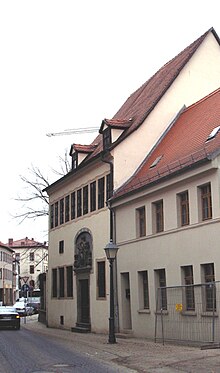
Saxony-Anhalt is a state of Germany, bordering the states of Brandenburg, Saxony, Thuringia and Lower Saxony. It covers an area of 20,451.7 square kilometres (7,896.4 sq mi) and has a population of 2.17 million inhabitants, making it the 8th-largest state in Germany by area and the 11th-largest by population. Its capital is Magdeburg and its largest city is Halle (Saale).

Wittenberg, is the fourth-largest town in Saxony-Anhalt, Germany. Wittenberg is situated on the River Elbe, 60 kilometers (37 mi) north of Leipzig and 90 kilometers (56 mi) south-west of Berlin, and has a population of 46,008 (2018).

The Wartburg is a castle originally built in the Middle Ages. It is situated on a precipice of 410 meters (1,350 ft) to the southwest of and overlooking the town of Eisenach, in the state of Thuringia, Germany. It was the home of St. Elisabeth of Hungary, the place where Martin Luther translated the New Testament of the Bible into German, the site of the Wartburg festival of 1817 and the supposed setting for the possibly legendary Sängerkrieg. It was an important inspiration for Ludwig II when he decided to build Neuschwanstein Castle.

Halle (Saale), or simply Halle (German:[ˈhalə]; from the 15th to the 17th century: Hall in Sachsen; until the beginning of the 20th century: Halle an der Saale ; from 1965 to 1995: Halle/Saale) is the largest city of the German state of Saxony-Anhalt, the fourth most populous city in the area of former East Germany after (East) Berlin, Leipzig and Dresden, as well as the 31st largest city of Germany, and with around 244,000 inhabitants, it is slightly more populous than the state capital of Magdeburg. Together with Leipzig, the largest city of Saxony, Halle forms the polycentric Leipzig-Halle conurbation. Between the two cities, in Schkeuditz, lies Leipzig/Halle International Airport. The Leipzig-Halle conurbation is at the heart of the larger Central German Metropolitan Region.
Wittenberg is a district in the east of Saxony-Anhalt, Germany. Neighboring districts are Anhalt-Bitterfeld, the district-free city of Dessau-Roßlau, the districts of Potsdam-Mittelmark, Teltow-Fläming and Elbe-Elster in Brandenburg, and the district of Nordsachsen in Saxony. The capital and largest city is Wittenberg, famous for its association with the influential religious reformer Martin Luther and containing a UNESCO World Heritage Site.
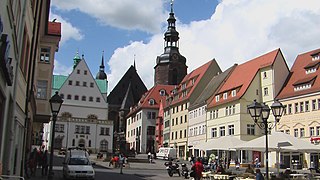
Eisleben is a town in Saxony-Anhalt, Germany. It is famous as both the hometown of the influential theologian Martin Luther and the place where he died; hence, its official name is Lutherstadt Eisleben. First mentioned in the late 10th century, Eisleben is divided into old and new towns, the latter of which was created for Eisleben's miners in the 14th century. As of 2020, Eisleben had a population of 22,668. It lies on the Halle–Kassel railway.
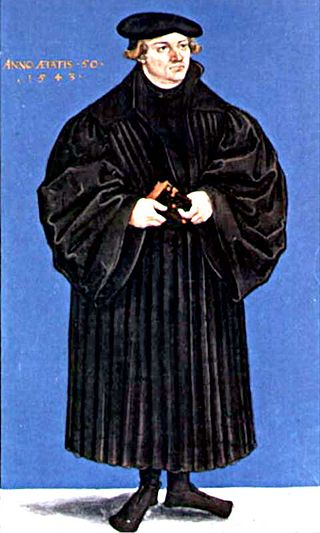
Justus Jonas, the Elder, or simply Justus Jonas, was a German Lutheran theologian and reformer. He was a Jurist, Professor and Hymn writer. He is best known for his translations of the writings of Martin Luther and Philipp Melanchthon. He accompanied Martin Luther in his final moments.

Mansfeld, sometimes also unofficially Mansfeld-Lutherstadt, is a town in the district of Mansfeld-Südharz, in Saxony-Anhalt, Germany.
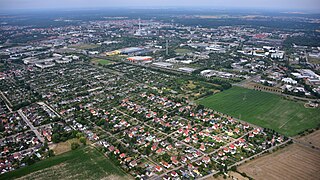
Dessau-Roßlau is a kreisfreie Stadt in the German state of Saxony-Anhalt. It is situated at the confluence of the rivers Elbe and Mulde. The town was formed by merger of the towns of Dessau and Roßlau as part of the 2007 regional boundary reform of Saxony-Anhalt. The reform involved a reduction in the number of rural districts in Sachsen-Anhalt from 21 to 11, in anticipation of a continued population decline.
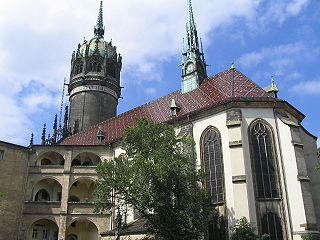
All Saints' Church, commonly referred to as Schlosskirche to distinguish it from the Stadtkirche of St. Mary's, sometimes known as the Reformation Memorial Church, is a Lutheran church in Wittenberg, Saxony-Anhalt, Germany. It is the site where, according to Philip Melanchthon, the Ninety-five Theses were posted by Martin Luther in 1517, launching the beginning of the Protestant Reformation.

The Stadt- und Pfarrkirche St. Marien zu Wittenberg is the civic church of the German town of Lutherstadt Wittenberg. The reformers Martin Luther and Johannes Bugenhagen preached there and the building also saw the first celebration of the mass in German rather than Latin and the first ever distribution of the bread and wine to the congregation – it is thus considered the mother-church of the Protestant Reformation. In 1996, it was inscribed on the UNESCO World Heritage List along with Castle Church of All Saints (Schlosskirche), the Lutherhaus, the Melanchthonhaus, and Martin Luther's birth house and death house in Eisleben, because of its religious significance and testimony to the lasting, global influence of Protestantism.

The Lutherhaus is a writer's house museum in Lutherstadt Wittenberg, Germany. Originally built in 1504 as part of the University of Wittenberg, the building was the home of Martin Luther for most of his adult life and a significant location in the history of the Protestant Reformation. Luther was living here when he wrote his 95 Theses.
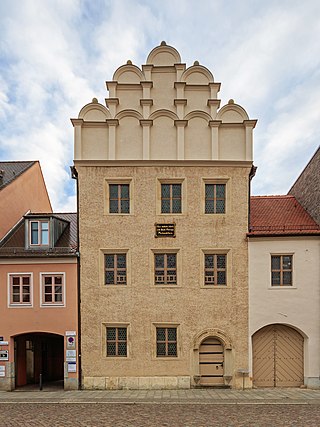
The Melanchthonhaus is a writer's house museum in the German town of Lutherstadt Wittenberg. It is a Renaissance building with late Gothic arched windows and the broad-tiered gables. It includes the study of the influential Protestant Reformer Philipp Melanchthon, who lived there with his family. In 1954 the house became a museum on Melanchthon's life and work displaying paintings, prints and manuscripts by him and his contemporaries. In 1996, the building became a UNESCO World Heritage Site along with sites associated with Melanchthon's contemporary Martin Luther in Witternberg and Eisleben because of their religious significance and the lasting, global influence of Protestantism.

Martin Luther University Halle-Wittenberg, also referred to as MLU, is a public research university in the cities of Halle and Wittenberg. It is the largest and oldest university in the German state of Saxony-Anhalt. MLU offers German and international (English) courses leading to academic degrees such as BA, BSc, MA, MSc, doctoral degrees, and Habilitation.
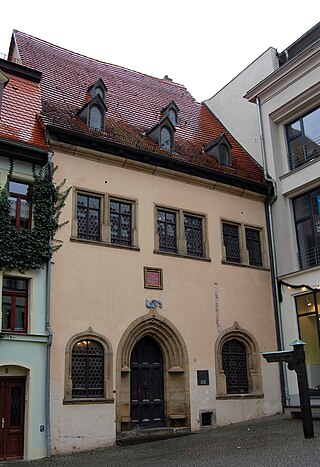
Martin Luther's Death House is a historic building in Eisleben, Saxony-Anhalt Germany, long regarded as the place where the influential theologian Martin Luther died on 18 February 1546. Along with Martin Luther's Birth House in Eisleben and other sites associated with Martin Luther in Wittenberg, the building was inscribed on the UNESCO World Heritage List in 1996. It is now a museum.

Lutherhaus Eisenach is one of the oldest surviving half-timbered houses in Thuringia. Tradition holds that Martin Luther lived there with the Cotta family during his schooldays in Eisenach from 1498 to 1501. The Lutherhaus has been one of the most important historic Reformation sites since the 19th century and, as such, was designated a "European cultural heritage site" in 2011. The Lutherhaus has been run as a cultural history museum since 1956.

St. Augustine's Monastery in Erfurt, central Germany, is a former church and monastery complex dating from the 13th century. The site is almost one hectare in size. It was built by Augustinian friars, an order of the Catholic Church. It is most well known as the former home of Martin Luther (1483–1546), the father of the Reformation, who lived there as a friar from 1505 until 1511.

A Lutherstadt is a city German protestant reformer Martin Luther visited or played an important role. Two cities, Lutherstadt Eisleben and Lutherstadt Wittenberg, have "Lutherstadt" in their official names, while Mansfeld-Lutherstadt is the unofficial name of a district in Mansfeld. These three places which were important in Luther's life were awarded the "European Heritage Label".
Edwin Werner is a German musicologist and Handel scholar.
